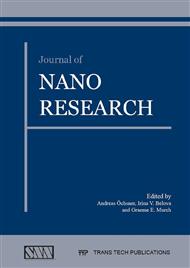[1]
H. Kurita, M. Estili, H. Kwon, T. Miyazaki, W. Zhou, J. -F. Silvain, A. Kawasaki, Load-bearing contribution of multi-walled carbon nanotubes on tensile response of aluminium, Compos. Part A- Appl. S. 68 (2015) 133–139.
DOI: 10.1016/j.compositesa.2014.09.014
Google Scholar
[2]
L. Wang, Z. Zhang, X. Han, In situ experimental mechanics of nanomaterials at the atomic scale, NPG Asia Materials 5 (2013) e40.
DOI: 10.1038/am.2012.70
Google Scholar
[3]
C. Kallesøe, M.B. Larsen, P. Bøggild, K. Mølhave, 3D mechanical measurements with an atomic force microscope on 1D structures, Rev Sci Instrum 82 (2012) 023704.
DOI: 10.1063/1.3681784
Google Scholar
[4]
S.I. Yengejeh, S.A. Kazemi, A. Öchsner, Advances in mechanical analysis of structurally and atomically modified carbon nanotubes and degenerated nanostructures: A review, Compos. Part B-Eng. 86 (2016) 95–107.
DOI: 10.1016/j.compositesb.2015.10.006
Google Scholar
[5]
H.W. Zhang, J.B. Wang, X. Guo, Predicting the elastic properties of single-walled carbon nanotubes, J. Mech. Phys. Solids 53 (2005) 1929–(1950).
DOI: 10.1016/j.jmps.2005.05.001
Google Scholar
[6]
S.S. Gupta, R.C. Batra, Continuum structures equivalent in normal mode vibrations to single-walled carbon nanotubes, Comput. Mater. Sci. 43 (2008) 715–723.
DOI: 10.1016/j.commatsci.2008.01.032
Google Scholar
[7]
R. Rafiee, R.M. Moghadam, On the modelling of carbon nanotubes: A critical review, Compos.: Part B-Eng. 56 (2014) 435–449.
Google Scholar
[8]
C. Li, T.W. Chou, A structural mechanics approach for the analysis of carbon nanotubes, Int. J. Solids Struct. 40 (2003) 2487–2499.
Google Scholar
[9]
K.I. Tserpes, P. Papanikos, Finite Element modeling of single-walled carbon nanotubes, Compos. Part B–Eng. 36 (2005) 468–477.
DOI: 10.1016/j.compositesb.2004.10.003
Google Scholar
[10]
N.A. Sakharova, A.F.G. Pereira, J.M. Antunes, C.M.A. Brett, J.V. Fernandes, Mechanical characterization of single-walled carbon nanotubes: Numerical simulation study, Compos. Part B–Eng. 75 (2015) 73–85.
DOI: 10.1016/j.compositesb.2015.01.014
Google Scholar
[11]
P. Papanikos, D.D. Nikolopoulos, K.I. Tserpes, Equivalent beams for carbon nanotubes, Comput. Mater. Sci. 43 (2008) 345–352.
DOI: 10.1016/j.commatsci.2007.12.010
Google Scholar
[12]
X. Lu, Z. Hu, Mechanical property evaluation of single-walled carbon nanotubes by finite element modelling, Compos.: Part B-Eng. 43 (2012) 1902–(1913).
DOI: 10.1016/j.compositesb.2012.02.002
Google Scholar
[13]
C. Li, T.W. Chou, Elastic moduli of multi-walled carbon nanotubes and the effect of van der Waals forces. Compos. Sci. Technol. 63 (2003) 1517–1524.
DOI: 10.1016/s0266-3538(03)00072-1
Google Scholar
[14]
A.L. Kalamkarov, A.V. Georgiades, S.K. Rokkam, V.P. Veedu, N.M. Ghasemi-Nejhad, Analytical and numerical techniques to predict carbon nanotubes properties, Int. J. Solids Struct. 43 (2006) 6832–6854.
DOI: 10.1016/j.ijsolstr.2006.02.009
Google Scholar
[15]
M. Rahmandoust, A. Öchsner, On finite element modeling of single- and multi-walled carbon nanotubes, J. Nanosci. Nanotech. 12 (2012) 8129–8136.
DOI: 10.1166/jnn.2012.4521
Google Scholar
[16]
A. Ghavamian, M. Rahmandoust, A. Öchsner, A numerical evaluation of the influence of defects on the elastic modulus of single and multi-walled carbon nanotubes, Comput. Mater. Sci. 62 (2012) 110–116.
DOI: 10.1016/j.commatsci.2012.05.003
Google Scholar
[17]
C.W. Fan, Y.Y. Liu, Chyanbin Hwu, Finite element simulation for estimating the mechanical properties of multi-walled carbon nanotubes, Appl. Phys. A-Mater. 95 (2009) 819–831.
DOI: 10.1007/s00339-009-5080-y
Google Scholar
[18]
M.N. Nahas, M. Abd-Rabou, Finite element modeling of multi-walled carbon nanotubes, Int. J. Eng. Sci. 10 (2010) 63–71.
Google Scholar
[19]
M.S. Dresselhaus, G. Dresselhaus, R. Saito, Physics of carbon nanotubes, Carbon 33 (1995) 883–891.
DOI: 10.1016/0008-6223(95)00017-8
Google Scholar
[20]
O.V. Kharissova, B.I. Kharisov, Variations of interlayer spacing in carbon nanotubes, RSC Adv. 58 (2014) 30807–30815.
DOI: 10.1039/c4ra04201h
Google Scholar
[21]
C. -H. Kiang, M. Endo, P.M. Ajayan, G. Dresselhaus, M.S. Dresselhaus, Size effects in carbon nanotubes, Phys. Rev. Lett. 81 (1998) 1869–1872.
DOI: 10.1103/physrevlett.81.1869
Google Scholar
[22]
S. Melchor, J.A. Dobado, CoNTub: an algorithm for connecting two arbitrary carbon nanotubes, J. Chem. Inf. Comp. Sci. 44 (2004) 1639–1646.
DOI: 10.1021/ci049857w
Google Scholar
[23]
B.R. Gelin, Molecular modelling of polymer structures and properties, Hanser/Gardner Publishers, Cincinnati (OH), (1994).
Google Scholar
[24]
W.D. Cornell, P. Cieplak, C.I. Bayly, I.R. Gould, K.M. Merz, D.M. Ferguson, et al., A second generation force-field for the simulation of proteins, nucleic acids and organic molecules, J. Am. Chem. Soc. 117 (1995) 5179–5197.
DOI: 10.1021/ja00124a002
Google Scholar


